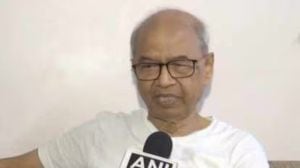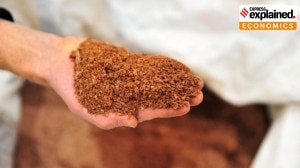Surat comes full circle with flood
Surat has learnt to live with tragedy in the past four years. Its officials apparently haven't. The plague that followed the floods of 19...

Surat has learnt to live with tragedy in the past four years. Its officials apparently haven’t. The plague that followed the floods of 1994 was believed to have shaken up the administration, even bringing in S.R. Rao who made Surat the country’s second-cleanest city. However, it has taken just one wave of water to wipe all that away. The recent floods have pushed Surat back to the days of garbage piles, rotting carcasses and the infamous face masks. As fears of another plague haunted residents, the question being asked is “How could the city return to this?”, “What went wrong?”.
The answer isn’t too hard to find. Despite the international brouhaha over the 1994 plague, officials just weren’t prepared to meet such a crisis.
The flood was caused by heavy rains in the catchment areas (in Madhya Pradesh) of the Ukai dam, forcing the authorities to release water into the Tapi river at double the rate of its carrying capacity. Alarmed, the Central Water Commission alerted the district administration and theGujarat Government of a massive flood. Less than four hours later, water started gushing into the Tapi. During its best days, the river has 3.66 lakh cusecs of water; on September 15, it was carrying as much as 9 lakh cusecs.
The volume was so high that it caught everyone on the wrong foot; District Collector R.M. Shah had, in fact, just announced on television that the water level would not be higher than 1994. While the amount of water may have left them surprised, the officials had no idea of the state of the Tapi either. No one seemed to have taken into account the heavy silting of its bed and the missing embankments at various places. Former Congress chief minister Amarsinh Chaudhary, also an ex-irrigation minister, says water was needlessly allowed to collect in the Ukai dam. He insists officials should have started releasing it when the level was 330 feet rather than waiting for the full reservoir level of 345 feet.
By September 16, almost half lakh people had been evacuated to safer parts in thecity. By the next day, there were almost no safe parts left, with 80 per cent of Surat under water. When the water did start receding, it left behind another nightmare: the complete breakdown of civic administration.Ironically, after the 1994 floods, the state Government had drawn up a master plan to prevent precisely such a situation. Had it seen implementation, the civic authorities would have had 100 boats and storm water-drainage sluice gates at disposal points. In contrast, it had just 21 boats, many of them non-functional. All Additional Chief Secretary (Finance) K.V. Bhanujan has to say now is: “That plan will have to be updated as figures quoted then are no more relevant.” Experts say though the flood could not have been averted, its impact could easily have been minimised.
Through simple methods like desilting, dredging and efficient water management.
In fact, construction of embankment walls along the Tapi had been initiated along with some more rivers in Gujarat. But after building wallsalong a stretch of only 2.5 km, the state Government gave up the project, saying it was too expensive. Worse, the existing embankments have been breached at various places, reportedly by contractors issued leases for sand mining by the Government. Now, District Collector and Municipal Commissioner S.
Jagadeesan says the offenders will be penalised and money needed to rebuild the walls be recovered from them. Desilting of the Tapi, on the other hand, has never been taken up. The amount of silting in the river can be gauged from the fact that back in 1968, the rate of inflow of water into it used to be as high as 15 lakh cusecs and it could carry 3.66 lakh cusecs of flood water. Now, it can’t carry more than 2.5 lakh cusecs. Though the Gujarat Maritime Board at Surat did have two dredgers, both have been sent to Saurashtra for reasons best known to the administration.
Again, the authorities now admit desilting is urgently needed. However, others point out that this may not be easy, particularly consideringthe expense involved and the possibility of similar demands for other rivers.Post-floods, the helicopters pressed into service, the civic body and the administration came in for flak for the slow pace of cleanliness. The job was enormous considering the garbage, rotting grains and animals, and slush spread over 112 sq km. To make it worse, many of the civic officials were themselves cut off due to the flood. The department had to reinforce its strength with staff from other cities, who took two-three days arriving.
But Municipal Commissioner Jagadeesan shrugs off complaints of tardiness, terming them media hype and insisting the people are happy with the civic body. He also insists that 85 to 90 per cent of the garbage had been cleared within 72 hours of the flood. However, the city had gone into panic by then. Many power loom workers stayed away from work and some residents even left the city. Others took their fury out on anyone who looked like a politician, including former chief minister ShankersinhVaghela and Surat MP Kashiram Rana. The situation was made worse by rumours some of them reported in the local Press that rodents had started showing plague symptoms.
The worst affected were those staying near the river bed. When the Tapi went in spate, it swept away the houses of most of them. Former mayor Fakirbhai Chauhan is not very hopeful that a solution can be found to the problem of their rehabilitation. “At least 5,000 families stay there and each would take a minimum of Rs 50,000 for rehabilitation, which is a tall order,” he points out.
The Centre hasn’t announced any relief so far, despite the fact that the state has a BJP government and a minister in the Union Cabinet, Kashiram Rana. The state Government’s grant of Rs 9 crore in three phases works out to as meagre as Rs 1,500 per family.
The Municipal Corporation, meanwhile, also wants money. It has sought aid from the state Government for a Rs 37-crore plan that will involve construction of embankment walls (for Rs 14 crore) andrehabilitation of about 10,000 families living near the river bed. The corporation estimates each pucca house will cost at least Rs 70,000 to build. Besides, it wants Rs 1.5 crore for buying 50 mechanised boats. This, significantly, is half of what the 1994 master plan had suggested.





- 01
- 02
- 03
- 04
- 05


























